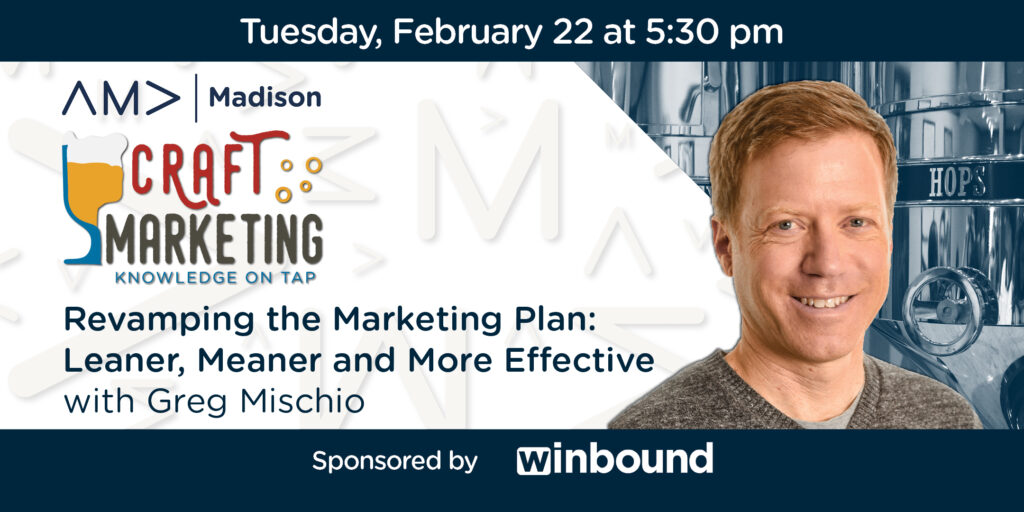Greg Mischio of Winbound shared a more dynamic, inclusive approach to marketing planning at AMA Madison’s Craft Marketing presentation on February 22nd.
In his presentation, Greg shared the approach to marketing planning that he has applied with his clients for best results.
Thanks to our sponsor:
Why Marketing Planning is Important
Greg began by addressing the truth of the matter: nobody enjoys planning. But it is a necessary evil. When done right, plans, strategy, and revisiting these resolutions can be a competitive advantage:
- 65% of the most successful marketers have a documented strategy, compared to only 14% of these marketers lacking one. -Content Marketing Institute
- Marketers with a documented strategy are 313% more likely to report success. -CoSchedule
Still, even when we formally document our strategies and plans, it’s easy never to revisit them.
So, How Do We Avoid a Dusty Document?
To attack this common outcome, Greg offered some tips:
Lean: Cut to the chase. Skip the extra jargon. Keep the contents of your plan concise.
Mean: Mean what you write. Construct actionable content and marketing strategies.
More Effective: Tie your plan into goals and set a framework for metrics.
7 Steps to Creating a Lean, Mean, More Effective Marketing Plan
Step 1: Get Organizational Buy-In Around “The Baby”
When you’re ready to begin constructing your marketing plan, getting sales and marketing people on board can be like pulling teeth. Greg shared that in his experience with a client, they found success in telling people to “make the customer the baby.” He explained that friends and family rally together when a new baby arrives, devoting all their attention to the new addition. Similarly, when creating a marketing plan, you want your entire marketing team and beyond to come together and give their all. To do this, Greg suggested involving them in creating a Digital Twin.
The Digital Twin
According to Gartner, by 2025, 80% of the sales cycle will occur via digital channels.
Cue the “digital twin.” Greg explained that in the manufacturing world, a digital twin is a reproduction of a process or a product. This digital recreation is then used to prototype materials, augment processes, and improve upon the real thing.
Greg has since adapted the concept of the digital twin to create a new strategy for marketing planning. Specifically, we want to build a digital twin of the sales team using digital content.
How to Create a Digital Twin: Get Internal Feedback
Unite Different Perspectives. Recruit as many people across departments as you can. These people’s diverse perspectives will help you gather the necessary insights.
Distribute a Questionnaire. Next, it’s vital to collect answers to critical questions. Whether you issue a survey or a shared word document that the group fills out collectively, be sure it covers topics like:
- What do we do, and what are our capabilities?
- Who are our customers?
- What are their goals?
- What are their pain points or frustrations?
- What questions do they ask, and what objections do they raise?
- Why do they buy from us? How do we know this?
Review the Answers Together. When you get everyone in one room, examine each answer as a group. Record any additional feedback. These discussions can give you rich insights as a marketer regarding who your customer is.
Step 2: Build Bullet-Point Personas
Now that you have internal insights into your customers, it’s time to put it to work. Greg recommends simplifying the process with bullet-point personas rather than devoting lots of time to in-depth, traditional buyer personas.
Greg’s Tips for Creating Bullet-Point Personas:
Don’t Create Too Many Personas. Greg typically limits it to three key personas, adding their business titles if in the b2b space.
Use the Insights from the Internal Review. Fill out each persona with the questions and answers you gathered during your internal review meetings.
Keep It Simple. Use bullet points for characteristics and questions, and keep paragraphs short. The goal is to make it skimmable, so you can easily use it to develop and back up the decisions you make.
Make it Adjustable. It’s to your long-term benefit if you ensure that you can adjust this content over time.
Step 3: Create a Sales Story
Drawing from the insights of Mike Weinberg, author of “New Sales. Simplified.,” Greg proposes that we don’t need elevator pitches. Instead, you want to structure a sales story, so your sales team has a solid, holistic understanding of who the customer is.
To create your sales story, Greg recommends pulling information from your personas and using them to answer questions like:
- Overview – What do you do from a customer perspective?
- Questions – List out the problems and questions the customer has.
- Capabilities – Identify your capabilities and how they can address customer concerns.
- Differentiators – Provide the key points that make you stand out. Why are customers buying from you?
Get External Feedback
Greg advises that marketers get external feedback on the digital twin to validate its contents. You can accomplish this in a few ways:
Phone Surveys. Conduct 1:1 phone calls with customers to discuss your identified differentiators. For example, you can ask them to rate differentiators on a scale of 1 to 5 regarding which they value the most.
Keyword Research & Paid Ads. Running ads is another way to test and validate your data.
Step 4: Marketing Foundation Must Be In Place
Next, be sure to have the following assets down:
- A website
- Conversion elements on your website
- A CRM to keep track of your leads
- An analytics measurement structure, like Google Analytics
- Social media pages
How Does the Digital Twin Sell?
Greg explained that you can think of your content as your sales pitch or presentation, and the distribution of this content is like your marketing. He stressed that your content won’t get anywhere if you don’t have a marketing method to get the word out.
Step 5: Create a Content Strategy Using a Digital Twin Framework
Greg explained that people will do business with you if they know you, like you, and trust you. So naturally, it’s worthwhile to apply this approach to your content strategy.
“Know You” Content: Top of Funnel – Helpful Information
Focus: This type of content should focus on your customers’ problems, as per your personas.
Types: Blogs, videos, infographics, guest blogs, social media posts, podcasts.
Goal: Traffic, links, likes, impressions, brand awareness, newsletter sign-ups
“Like You” Content: Helpful Guides or Tools
Focus: This content should provide your customer with assets that help them do their jobs easier.
Types: Downloadable charts, checklists, online calculators, marketing templates
Goals: List building if it’s gated, downloads/shares if it’s ungated
“Trust You” Content – Bottom of the Funnel Buying Stage
Focus: With this content, you want to keep their attention on you.
Types: Website product/service pages, case studies
Goal: Form submission with detailed company information, phone inquiries
Step 6: Plan Your Content
When planning the specifics of your content strategy, you’ll want to consider two types of content: Paid and organic. Paid includes PPC, Social ads, and trade ads, while organic includes SEO, Social media, and Placement.
And if you’re unsure of what topics to write about, Greg suggests:
- Refer back to your personas. All the questions, objections, and challenges are content opportunities.
- Look at your differentiators. These are selling points that will bring you success.
- Use a spreadsheet to list your topic ideas. This format will allow you to go back and edit as time goes on.
Setting Goals
Finally, Greg offered some tips on goal setting for your marketing plan:
- Start from zero and establish benchmarks from the start. If you need a number, use the rule of three.
- Keep it simple by using the “Critical Few” metrics. What are the three key indicators that you need for success?
- Tell your sales team that my number is your number. Let them know that whatever number of leads they need is what you will shoot for. You’ll work backward to get there together.
See You at Capitol Brewery for March’s Craft Marketing
Craft Marketing invites you to its next live in-person event at Capitol Brewery in Middleton at 5:30 PM on March 29nd, 2022, where Steve Robinson of Brilliant Metrics will present “The Many Faces of Account-Based Marketing,” covering a variety of Account-Based Marketing strategies that have given his clients results, and how you can find the right fit for you.
About the Venue
Capital Brewery was founded in 1984, and brewed their first batch of beer, a pilsner, in the spring of 1986 and was founded to brew traditional German style lager beer in America. Capital has won over 240 awards at domestic and international competitions. The venue is located at 7734 Terrace Ave. in Middleton, WI.
Register here for the in-person event.

Kara Martin, Content Writer at Naviant, specializes in written B2B content, from case studies to blogs. She transforms complex technical information into compelling, data-driven content.


